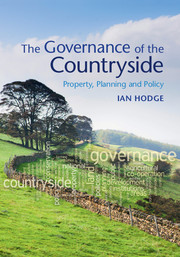Book contents
- Frontmatter
- Contents
- Preface
- Acknowledgements
- List of abbreviations
- Part I Introduction
- Part II Historical models
- 4 Cooperation for production: common fields and enclosure
- 5 Delivering diversity: the Great Estates and the management of the land
- Part III Governance under sectoral policies
- Part IV Alternative approaches to governance
- Part V Conclusions
- References
- Index
5 - Delivering diversity: the Great Estates and the management of the land
from Part II - Historical models
Published online by Cambridge University Press: 05 February 2016
- Frontmatter
- Contents
- Preface
- Acknowledgements
- List of abbreviations
- Part I Introduction
- Part II Historical models
- 4 Cooperation for production: common fields and enclosure
- 5 Delivering diversity: the Great Estates and the management of the land
- Part III Governance under sectoral policies
- Part IV Alternative approaches to governance
- Part V Conclusions
- References
- Index
Summary
If a moderate estate in land be left to a man now, there arises the question of whether he is not damaged unless an income also be left wherewith to keep up the estate. Land is a luxury, and of all luxuries it is the most costly.
Anthony Trollope (first published 1875) The Way We Live Now. Dover Publications Inc., New YorkThen you hadn't to chop branches off trees, and you'd to leave a good big wide hedge bottom, for game purposes: and hadn't to have your horsemen at work in the fields, if it interfered with the drives of the birds. Nor you mustn't shoot hares, except one day a year, when they had a farmer's shoot: that was at February time, the last of the hare shooting, when the Hall had had their pick of hares…
The gamekeeper was a powerful man: anything he said was law.
Bill Denby, tenant farmer at Heslington Hall, near York, in 1930, in Charles Knightly (1984) Country Voices. Life and Lore in Farm and Village. Thames and Hudson, London (p. 171)5.1 Introduction
The common field system, as discussed in the previous chapter, governed the access that people had to the use of the land both for agricultural production and for a wide range of countryside products. Rights to land were shared in a variety of ways amongst different people. The idea of ‘ownership’, as we would understand it now, in the sense of near-complete control over a particular plot of land, was something that emerged over time. Full control over all aspects of land use could only be secured through the accumulation of the individual rights attached to particular parcels of land. Such control was gradually gained over very extensive areas by the private owners of the Great Estates, reaching a peak late in the nineteenth century. Land provided such owners with a variety of benefits: monetary, aesthetic, recreational and social. The Great Estates then represent another version of multifunctionality in the management of an area of land to deliver a variety of commodities and non-marketed outputs, but in this case the non-financial benefits were internalised through the ownership of a single individual or family; a single residual claimant.
- Type
- Chapter
- Information
- The Governance of the CountrysideProperty, Planning and Policy, pp. 85 - 106Publisher: Cambridge University PressPrint publication year: 2016



